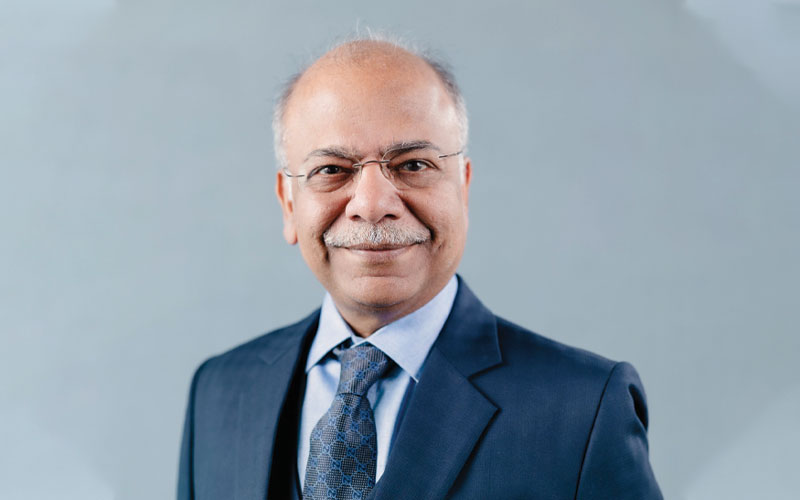Group Nirmal has announced that it is investing INR 100 crore to expand its production capacity by 7,000 tonnes per month for steel wire and 5,000 tonnes per month for aluminum within the current fiscal year. This expansion is primarily centered at Khordha (Odisha) manufacturing facility and partially at Deulti (West Bengal). In an exclusive interview with Wire & Cable India, Mr. Nirmal Saraf, Managing Director of Group Nirmal highlights that Group Nirmal is the first Indian company to receive a JIS (Japanese Industrial Standards) certification for its galvanized wires, and is recognized 2 Star Export House by Government of India, exporting steel wire products to over 42 countries spanning Japan, Africa, Europe, and the Americas.

Wire & Cable India: Could you please tell us about your company, your product portfolio and manufacturing capacities, especially for the steel wire segment.
Nirmal Saraf: Group Nirmal is a prominent player in India’s steel and wire industry, backed by over 5 decades of expertise, and a commitment to innovation and engineering excellence.
With a strong presence in both national and international markets, we have grown into a multi-product, and multi-location enterprise known for delivering quality at scale. Our diverse manufacturing portfolio spanning over 2,000 SKUs includes galvanized and black steel wires, zinc wires, aluminum conductors, power cables, fencing and concrete reinforcement solutions, welding electrodes and hot rolled steel products. These cater to critical sectors such as power, infrastructure, construction, agriculture, and defense.
Operating through 7 advanced manufacturing facilities and a team of 1,000+ skilled professionals, we deliver an annual production capacity of 2,16,000 metric tonnes.
Our steel wire segment stands as a key strength, with a monthly output of 15,000 metric tonnes that supports time-sensitive, large-scale requirements. We offer a comprehensive range of GI wires, being the first Indian company to earn Japanese Industrial Standards (JIS) certification, validating the superior strength, coating uniformity and durability of our wires.
Our GI wire portfolio includes high-performance utility-grade wires such as cable armouring wires, ACSR core wires, earth wires, guy wires, and stranded wires in configurations of up to 37 strands, each engineered for strength, precision, and long-term reliability.
Backed by innovation, international certifications, and scalable production capacity, our steel wire solutions continue to power critical infrastructure and industrial growth across India and global markets.
Further enriching our offerings is NIZNAL®, our proprietary zinc-aluminium alloy-coated steel wire, which offers a product life up to 6 times longer than traditional GI wires. NIZNAL® provides superior corrosion resistance and durability, especially in coastal and chemically aggressive environments.
Watch: Top Cable Companies in India
WCI: What are the current trends shaping the wire and cable industry in India, especially the steel wire sector?
NS: India’s wire and cable industry, particularly the steel wire segment is witnessing strong momentum, driven by government-led infrastructure programs, rural electrification, urban expansion, and clean energy adoption.
In 2024, insulated metallic wire and cable demand grew by 7.8% year-over-year, continuing a 6.4% CAGR through 2028. Simultaneously, wire rod consumption is rising steadily, with growing demand for high-tensile, galvanized, and zinc-aluminium alloy-coated steel wires across transmission, construction, fencing, and renewable energy sectors. These trends have accelerated automation in production, enhanced quality consistency, and expanded manufacturing capacities across the world.
However, they also bring challenges such as increased capital expenditure, volatility in steel and copper prices, and a persistent need for skilled labor. Looking ahead, the industry is poised to shift toward premium, application-specific wires designed for EVs, solar infrastructure, smart grids, and sustainable construction. To stay competitive, manufacturers must embrace Industry 4.0 practices, invest in R&D and workforce upskilling, and adopt flexible procurement strategies to navigate raw material volatility and evolving market demands.
WCI: How do you see Indian steel wire manufacturers competing with global players in terms of quality, pricing, and technological advancements?
NS: Indian steel wire manufacturers are steadily strengthening their global competitiveness through a focused strategy built on quality enhancement, cost efficiency, and technological advancement.
With India targeting an increase in steel wire production from 5.6 million tonnes in FY2023 to nearly 9 million tons by FY2028, firms are leveraging economies of scale, low labor costs, and proximity to raw materials to maintain attractive pricing, while also complying with rigorous international quality benchmarks. Advanced testing protocols, superior surface finishes, and longer-lasting anti-corrosive coatings are now becoming standard, helping Indian wires match or surpass global counterparts.
Despite this, the industry is facing challenges like fluctuating input costs, dependence on imported high-tech machinery and regional infrastructure gaps are hindering large-scale technological adoption.
To overcome these challenges, manufacturers are pursuing backward integration, investing in digital process automation, and tapping into PLI schemes to modernize operations.
As these interventions mature, they are expected to enhance global price competitiveness, enable consistent high-grade output, and position Indian steel wires as a strong alternative to established international suppliers.

India is targeting an increase in steel wire production from 5.6 million tonnes in FY 2023 to nearly 9 million tonnes by FY 2028.
WCI: What are the challenges faced by the Indian steel wire industry? How do you see the industry overcoming these challenges?
NS: India’s steel wire industry is moving steadily towards growth, but not without its share of complex challenges. Fluctuating raw material prices, particularly for steel and zinc, make it difficult for manufacturers to maintain stable pricing and profit margins.
Many still rely on imports due to the inconsistent quality and availability of domestic inputs. High energy costs and power disruptions further increase production expenses.
On the operational side, older machinery, especially in smaller and mid-sized units, limits both efficiency and the ability to meet evolving quality standards. Logistics issues such as slow port clearance, high transport costs, and poor connectivity continue to affect supply chain performance.
However, the industry is responding with practical solutions. Manufacturers are upgrading technology, embracing automation, and investing in energy-efficient systems to reduce long-term costs.
Efforts are also underway to build stronger domestic supply chains and reduce import dependency. With targeted government support through infrastructure projects, PLI schemes, and Make-in-India initiatives, the industry is well-placed to turn these challenges into opportunities for long-term, sustainable growth.
WCI: Can you tell us about your global presence and key export markets for steel products? Which industries do your products cater to?
NS: We have established a strong global presence, exporting our steel wire products to over 42 countries across key international markets. As a Government of India-recognized 2 Star Export House, we take pride in delivering high-quality, reliable products that meet the stringent requirements of global buyers.
Our footprint spans Japan, Africa, Europe, and the Americas, with each region recognizing us for our consistent quality, engineering reliability, and timely delivery.
Notably, we are the first Indian company to receive a JIS (Japanese Industrial Standards) certificate for our galvanized wires, a milestone that has significantly strengthened our reputation in quality-conscious markets like Japan. This certification underscores our commitment to global benchmarks and has helped position us as a trusted supplier in some of the most demanding export territories.
In the American markets, too, our adherence to high standards and customer-centric approach has made us a reliable partner. Internationally, our steel wire products serve a wide range of industries including power transmission and distribution, fencing, general engineering, and construction, supporting critical infrastructure and development projects worldwide.

The Indian steel wire market will grow at a 12.4 % CAGR in 2025, peaking at 13.3 % in 2027, with an overall CAGR of 5.6 % through 2031.
WCI: What are your future growth plans or investments aimed at strengthening your market position in the steel wire segment?
NS: Our growth strategy is anchored in a bold and forward-looking investment plan aimed at significantly strengthening our position in the steel wire and aluminum segment.
As part of this vision, we are investing INR 100 crores to expand our production capacity by 7,000 tonnes per month for steel wire and 5,000 tonnes per month for aluminum within the current fiscal year.
This expansion, primarily centered at our Khordha (Odisha) manufacturing facility and partially at Deulti (West Bengal), is a strategic move to cater to increasing demand across sectors such as power, construction, agriculture, fencing, railways, and general engineering.
Backed by streamlined production cycles and efficient lead times, we are confident of completing this capacity enhancement within the current calendar year. This initiative not only reinforces our commitment to high-quality manufacturing and timely delivery but also aligns with our focus on sustainable growth. It marks a decisive step towards consolidating our leadership in the wire industry and responding dynamically to evolving market needs.
Also Read: Usha Martin: Powering Landmark Infrastructure with High-Performance Wire Rope Solutions
WCI: How do you see the Budget for FY 2025-26 impacting the steel wire industry, and what opportunities do you think it offers for the sector? How is the government supporting the growth of this sector?
NS: We see the FY 2025–26 Budget as a game‑changer for steel wire manufacturing. India’s overall capital expenditure has surged to INR 15.5 lakh crore for infrastructure (highways, metros, housing), driving up demand for steel wire in construction and T&D applications.
The government’s target for the specialty steel under PLI Scheme 1.1 covering alloy and steel wires is INR 6,322 crore over FY 2025–30 and is expected to spur about INR 30,000 crore in investment and add 25 million tonnes to the current capacity.
Industry forecasts indicate the Indian steel wire market will grow at a 12.4 % CAGR in 2025, peaking at 13.3 % in 2027, with an overall CAGR of 5.6 % through 2031.
Further support includes impending safeguard duties on Chinese steel- 12 % provisional or up to 25 % to protect domestic margins. Additionally, the Steel Ministry is seeking INR 15,000 crore to incentivize low‑carbon steel production by 2030. Combined measures like capex stimulus, PLI incentives, import protection and green steel support will create a robust platform for the industry to ramp up output and innovate with sustainable products.

The government’s target for the specialty steel under PLI Scheme 1.1 covering alloy and steel wires is INR 6,322 crore over FY 2025–30 and is expected to spur about INR 30,000 crore in investment and add 25 million tonnes to the current capacity.





